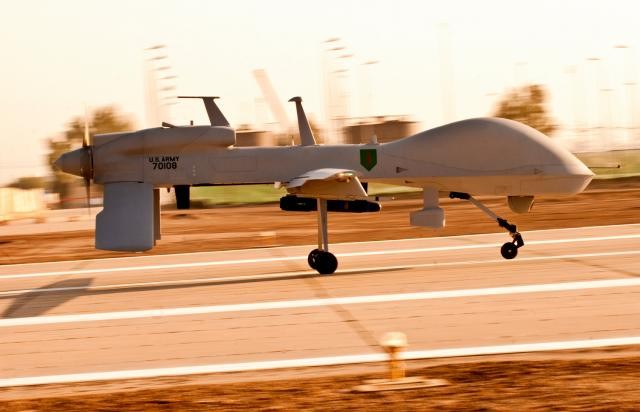ARLINGTON, Va. (Army News Service, Jan. 18, 2010) -- The Army is speeding up delivery of some of its newer Unmanned Aircraft System assets such as the Gray Eagle and expanding the size and range of its overall fleet to include a Family of Small UAS and a Vertical-Take-Off-and-Landing UAS, service officials said.
"We're going to accelerate Gray Eagle yet again. We're accelerating from two systems per year to three systems per year, which will result in seventeen systems being procured by FY 2014," said Tim Owings, deputy project manager for Army Unmanned Aircraft Systems.
A Defense Acquisition Board in February of this year is expected to confirm the addition of two more Low Rate Initial Production Gray Eagle systems - each consisting of 12 air vehicles, five ground control stations and five additional attrition vehicles, Owings said.
TWO GRAY EAGLES DEPLOYED
The Army has already deployed two Gray Eagle "Quick Reaction Capabilities." One QRC is now flying with Army Soldiers in Iraq and another is with U.S. Special Operations Forces in Afghanistan, Owings said.
The 28-foot-long surveillance aircraft has a 56-foot wingspan and is able to beam images from up to 29,000 feet for more than 24 hours at a time.
The QRC Gray Eagle aircraft are equipped with a laser designator, Signals Intelligence capability and an Electro-Optical/Infrared camera designed to survey the ground below, track enemy movements and hone in on targets. They are also equipped to carry HELLFIRE missiles, Owings said.
"We did just complete the weaponization of QRC 1 in Iraq. We now have flown flights in Iraq with the full weapons suite. They will have to go through a safety certification process on a firing range before they are allowed to go live," Owings said.
The QRC concept is designed to bring needed technologies to the battlefield in advance of a formal program of record in order to sharpen requirements and get desired capability in the hands of Soldiers sooner.
The Gray Eagle program will also go through a configuration change which will allow the Army to divide the systems up into three platoon-sized elements, Owings said. This will allow the Army to keep some aircraft back in the United States for training purposes while keeping most of the systems forward-positioned in theater.
HUMMINGBIRD QRC PLANNED
The Army's Program Office for UAS is also planning a QRC for the A160 Hummingbird Vertical-Take-Off-and-Landing, or VTOL UAS. It's a 35-foot-long helicopter-like unmanned system able to conduct Intelligence, Surveillance and reconnaissance or ISR missions and move cargo for more than 20 hours at altitude ceilings of up to 30,000 feet.
"We are currently outfitting an A160 with a Wide Area Surveillance payload and a SIGINT package. We intend to deploy a single A160 to Afghanistan later this year with two additional air vehicles now undergoing final integration for fielding in FY 12," Owings said. "The big advantage with the A160 is you get near fixed-wing endurance in a vertical-lift platform. That is something we have not seen before."
The first A160 aircraft was provided by the Defense Advance Research Project Agency. U.S Special Operations Command is providing the next two follow-on aircraft, Owings said.
The Army is also developing a formal requirement for a VTOL UAS designed to work in tandem with the A160 QRC, a process which will result in a formal competition and selection of a new capability, said Col. Rob Sova, capability manger for Unmanned Aircraft Systems, U.S. Army Training and Doctrine Command.
"We are going to be directed to do a VTOL requirements document," Sova said. "A VTOL Capabilities Development Document is the phase prior to the final document. We plan on doing a quick turn. We'll have that document done in the first half of the calendar year."
The A160 QRC will inform the requirements process, however the Army's formal VTOL program, ultimately, may or may not involve the A160, Owings and Sova indicated.
"Even if we wind up picking something different, we are going to learn a tremendous amount with the QRC we are doing with the A160. When you get to the field, you get a chance to vet things out and learn a lot on the materiel side," Owings said.
FAMILY OF SMALL UAS
The Army is also working on requirements for a Family of Small UAS - a process aided by the "Proof of Principle" deployment of several small UAS, including the Raven, Wasp and Puma.
- The Wasp Micro Air Vehicle is a small 1.25-foot, one-pound hand-held UAS able to beam images back to a ground controller from ranges up to five kilometers. The Wasp can fly for up to 45 minutes, Sova said.
- The Puma is a slightly larger UAS with a gimbaled camera. It can fly for 90 minutes. The Puma is 13 pounds and has a length of 4.6 feet and a wingspan of 9.2 feet; it can fly up to 500-feet in the air.
- The Raven, a four-pound, four-foot long UAS, has been used in theater to provide security for convoys and Forward Operating Bases, Sova said.
Much like a QRC, the "Proof of Principle" for the small UAS is designed to get capability in Soldier hands and also sharpen the requirements needed for the formal program of record.
"The requirements document is done. It is called the Rucksack Portable UAS requirements document. It needs to be amended because we got an increase in demand for the numbers so we are working on the total numbers," said Sova.
Related Links:
Army hits 1 million flight hours with unmanned aircraft
Army civilians work to provide lethal aerial vehicles to Soldiers
Gray Eagle UAS program expanding
Army.mil: Science and Technology News
STAND-TO!: Army Unmanned Aerial Systems Hits One Million Flight Hour Milestone
Office of the Assistant Secretary of the Army for Acquisition, Logistics and Technology




Social Sharing